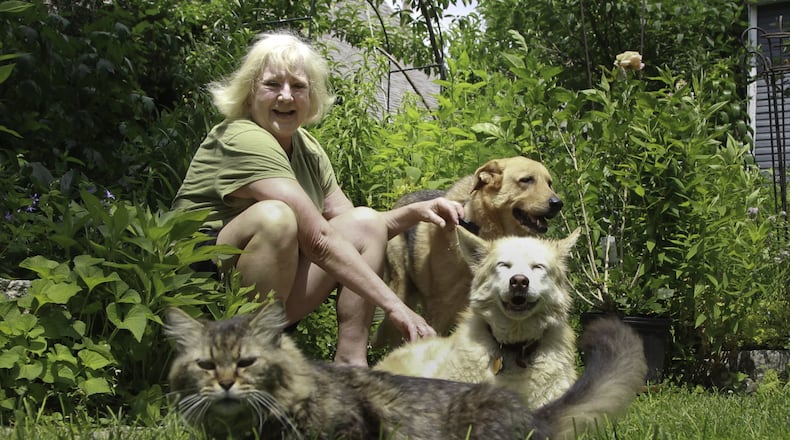Pet ownership in the U.S. by the numbers
$53.3 billion - Amount U.S. spent on pets in 2012
218 million - Number of pet owners in 2011
47% - Share of U.S. households that own dogs
37% - Share of U.S. households that own cats
$502 - Average household spending on pets in 2011
Sources: U.S. Bureau of Labor Statistics, American Pet Products Association
U.S. households spend more each year on their pets than they do on alcohol, furniture, landline phone service or men and boy’s clothing, according to U.S. Bureau of Labor Statistics data collected by the Census Bureau.
Pet ownership is at a record high nationwide, and the overwhelming majority of U.S. households now own pets, survey data show.
Americans love to treat their estimated 218 million furry, scaly, feathered and hoofed companions: Pet owners spent a record $53.3 billion on their critters last year.
Even during the economic downturn, spending on pet food remained stable, when most Americans cut back on dining out.
“That was a surprise to me, because anecdotally, I expected people to switch to generic 80 pound drums of dog food at Costco,” said Steve Henderson, with the Consumer Expenditure Survey division of the U.S. Bureau of Labor Statistics. “When people are faced with choices about where to spend their money, they take care of their pets.”
American households on average spent $502 on their pets in 2011, up from $480 in 2010, according to the Consumer Expenditure Survey. Spending on pets declined in 2009 and 2010 after peaking at $570 in 2008.
In 2011, households on average spent more on pets than they spent on utilities ($501), prescription and nonprescription drugs ($489), alcohol ($456), men and boys clothing ($404), landline telephone service ($381), non-alcoholic beverages ($361) and furniture ($358), survey data show.
Pets’ royal treatment
Pets love tasty treats and meals, and households spent about $183 on pet food in 2011, more than residents spent on cereal ($175), chicken ($124), bread ($107), candy ($87) and reading materials, the survey data show.
Average household spending on pet food rose 1 percent between 2008 and 2010. During the same time frame, average spending on dining out fell 7 percent.
When money gets tight, people often will cut back on discretionary expenses, such as entertainment, vacations and meals at restaurants.
But many pet owners are unwilling to downgrade to cheaper pet food.
“When there is a downturn, people tend not to travel as much, but they still cater to their pets because they believe they are part of the family,” said Rick Billups, vice president of marketing for Jack’s Pets, a Beavercreek-based chain of pet supply stores that has 30 locations across Ohio, Kentucky and Indiana.
Billups said during the depths of the recession customers often avoided purchases of pet toys and “impulse” items, but they continued buying the same quality of pet food.
Pet owners today are more nutrition-conscious about what they feed their companions, and they often want the healthiest option, he said.
Americans spent a record $53.3 billion on pets in 2012, up 4.7 percent from $51 billion in 2011, according to a different survey by the American Pet Products Association.
Sales of pet-related products have risen to record highs, partly because of increased ownership of animals.
Between 68 percent to 75 percent of U.S. households own pets, according to the two separate surveys.
About 56.7 million U.S. households own dogs (47 percent of the total) and 45.3 million own cats (37 percent), the association’s survey found.
About 12 percent of households own a freshwater fish; 6 percent own a bird or other small animal; 5 percent own a reptile; less than 3 percent own a horse and less than 2 percent own a saltwater fish.
More than four of every 10 pet-owning households own more than one type of pet.
Kris Rankin, 66, who lives in the Oregon District, said she owns two mixed-breed dogs and four cats. Rankin said buying her pets food can run between $30 to $40 each week.
“They get the good stuff — Iams,” she said.
Rankin said during the summer months she also spends about $150 per month on flea treatment.
“It’s like taking out a bank loan,” she said.
But the cost of taking care of her animals is well worth the cost, she said.
“You get companionship, humor, exercise,” she said. “The cats are extremely amusing.”
Bill Russett and his wife, Sharon, have been raising Lhasa Apsos since 1974 and are involved in both breeding and showing the fluffy dogs.
The Liberty Twp. couple participated in last week’s Greater Cincinnati Dog Show along with thousands of other canines, breeders and handlers and the three-day event.
As usual, the Butler County fairgrounds was lined with vendors offering specialty toys, food, beds and collars for the pooches as well as shirts and dog-themed jewelry for the humans.
“You can find just about anything,” Bill Russett said with a laugh. “Some people go overboard. They just spoil them,”
But that’s not to say the Russetts’ dogs don’t have a pretty cushy life. Jack, Gia and Checkers have their own plush beds and “there are toys all over the house … more than three need.”
He said responsible pet ownership can get expensive with vet visits and a multitude of supplies available at all prices.
“Right now treats seem to be the thing. Dog love them and people like to buy them. They come in all shapes and sizes now,” he said with a laugh. Gone are the days of the basic boxed dog biscuit.
Staff writer Lauren Pack contributed to this report.
About the Author

